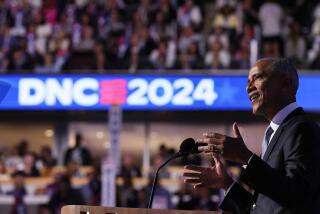Obama warns colleges about tuition
ANN ARBOR, MICH., AND WASHINGTON — President Obama embraced the idea of federal action to restrain the rapidly increasing cost of higher education, giving a boost to a long-simmering policy idea that has gained steam amid growing frustration with rising tuition.
His proposal that colleges and universities cut costs or risk losing out on some federal aid was part of a larger package of ideas for college affordability unveiled by the president on Friday in a speech at the University of Michigan. Obama wants to increase funds for higher education, mostly through an expansion of federal loan programs. He also will require colleges and universities to give families standardized information to allow comparison shopping on financial aid packages, graduation rates and employment prospects for graduates.
Obama also called for Congress to act to prevent a doubling of the interest rate this summer for the government’s subsidized Stafford loan program, which covers more than 7 million students. The rate is scheduled to increase from 3.4% to 6.8% on July 1. White House officials believe a late-spring confrontation over the loan rate could put Republicans in a politically costly position, much as the debate over the payroll tax cut did in December.
But creating federal incentives to cut costs was the proposal that caught education experts’ ears. Members of Congress, including some leading Republicans, have proposed similar ideas in the past, but college and university officials have opposed them, and the plans have gone nowhere. Obama’s speech marked the first time such a proposal had received a presidential endorsement.
Holding the line
Schools can’t just “jack up tuition every single year” and simply expect people to pay it, Obama said. “If you can’t stop tuition from going up,” he warned colleges, “the funding you get from taxpayers every year will go down.”
“I am only standing here because scholarships and student loans gave me a shot at a decent education,” Obama told the crowd at the Ann Arbor campus, where students braved early-morning snow to stand in line to see him.
“Your president and your first lady were in your shoes just a few years ago. We didn’t come from wealthy families. The only reason we were able to achieve what we achieved was because of education.”
Tuition increases have outstripped inflation for years, and the rising cost of college, coupled with deep cuts in state funds for public university systems from California to New York, have caused a clamor for solutions to make college more affordable.
Under the Obama plan, schools that raised tuition beyond what the government deemed an acceptable level could lose some of the billions of dollars in campus-based financial aid awarded by the federal government each year. Schools that demonstrated improvement would have a leg up in the yearly competition for money.
The proposal drew a mixed response from higher-education officials and experts.
Adding accountability to the billions of dollars the government makes available for financial aid is a reasonable request, said William G. Tierney, director of the Center for Higher Education Policy Analysis at the University of Southern California.
“The reality is the federal government provides funding to these institutions through students, and all the federal government is trying to do is ensure that the money they’re spending on our behalf is being wisely spent,” Tierney said.
State cuts hurt
University of California system President Mark G. Yudof said he supported much of the Obama proposal but cautioned that the main cause of the sharp tuition inflation at many state universities, including UC, has been a deep cut in the support the schools receive from state budgets.
“If the state subsidy is going through the floor, there are only so many places we can go to for funding,” Yudof said. UC has cut the cost of an average credit hour of courses by 15% in recent years through increasing class sizes and improving efficiency, but tuition still had to be raised to make up for reductions in state support, he said.
Yudof and others also warned that any federal effort would need to take into account the amount of money schools set aside for financial aid. UC, for example, sets aside a third of its tuition to pay for financial aid for low- and middle-income students. One way to lower tuition would be to reduce that set-aside -- the opposite of what Obama would like to achieve, he said.
Obama’s plan would increase the government’s Perkins loan program from $1 billion to $8 billion. Perkins funding is allocated to schools, which provide loans to their students. Because students repay Perkins loans with interest, the increase would not worsen the federal deficit, administration officials said.
Republicans gave Obama’s proposals mixed reviews. Rep. John Kline of Minnesota, chairman of the House education committee, praised the call for greater accountability and transparency, but he seemed to throw cold water on extending the low interest rate on Stafford loans.
“The interest rate hike students face is the result of a ticking time bomb set by Democrats five years ago” when the interest rate was reduced, Kline said in a statement. “Simply calling for more of the same is a disservice to students and taxpayers.”
--
kathleen.hennessey@latimes.com
christi.parsons@latimes.com
Times staff writer Larry Gordon in Los Angeles contributed to this report.
More to Read
Sign up for Essential California
The most important California stories and recommendations in your inbox every morning.
You may occasionally receive promotional content from the Los Angeles Times.











